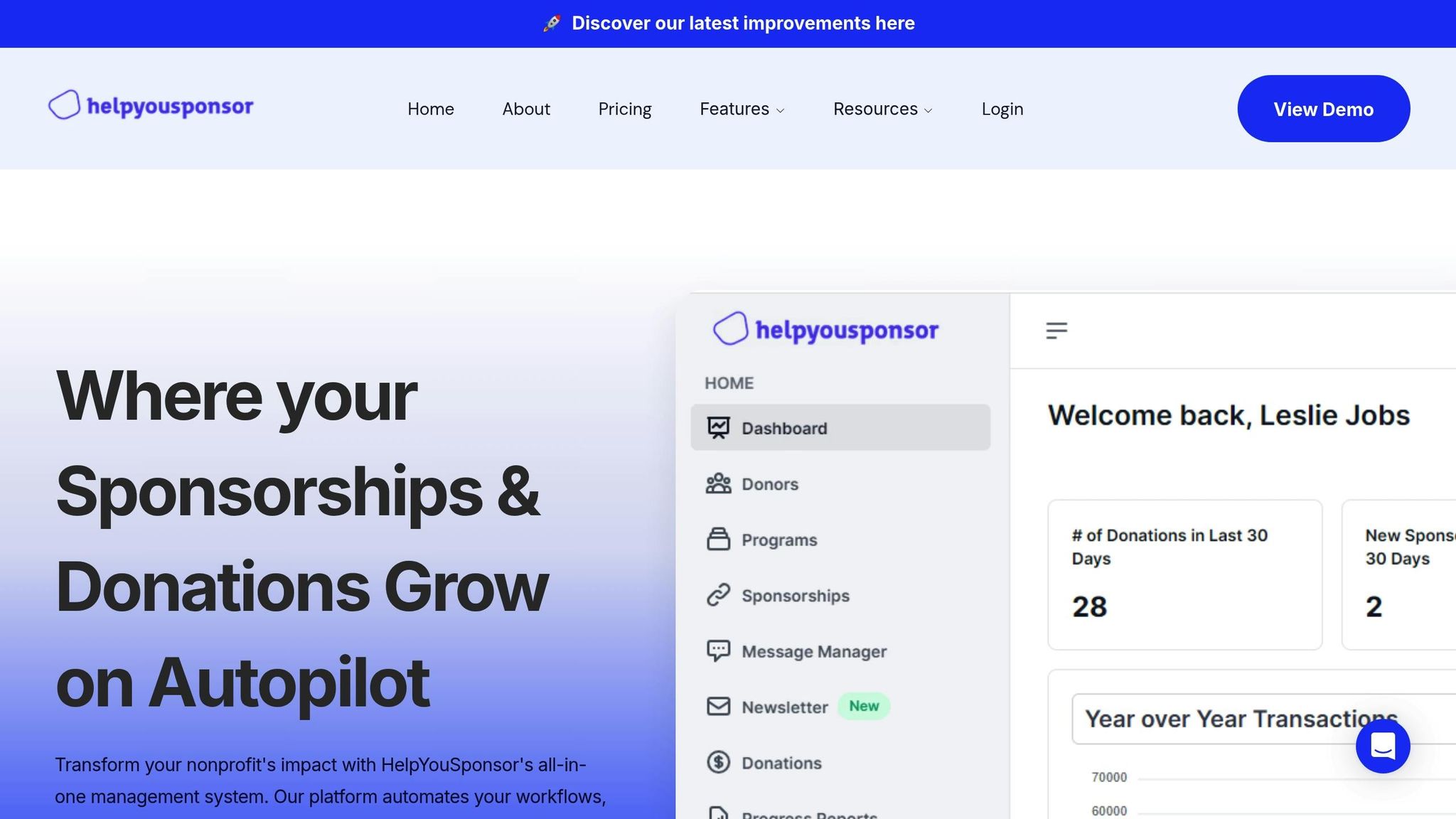Child Protection Policies vs. Risk Management Plans
Explore how child protection policies and risk management plans work together to ensure safety in nonprofits serving children.

Child protection policies and risk management plans are critical for nonprofits working with children. While they share the goal of ensuring safety, they address it from different angles:
- Child Protection Policies: Focus on preventing child abuse and mistreatment. They include clear behavioral guidelines, reporting procedures, staff screening, and training.
- Risk Management Plans: Broader in scope, these identify and address organizational risks, such as financial fraud, legal compliance, and operational disruptions.
Key takeaway: Child protection policies create a safe environment for children, while risk management plans safeguard the organization as a whole. Together, they form a complete framework for safety and efficiency.
Quick Comparison
| Aspect | Child Protection Policies | Risk Management Plans |
|---|---|---|
| Focus | Child safety and abuse prevention | Broader organizational risks |
| Scope | Behavioral guidelines, reporting, and training | Operational, financial, legal, and reputational risks |
| Legal Compliance | Child protection laws and mandatory reporting | Insurance, grants, and governance standards |
| Response | Zero-tolerance actions for abuse | Risk assessment, mitigation, and contingency planning |
Child safe risk management animation
Child Protection Policies Explained
Child protection policies are the backbone of creating safe environments within nonprofits, fostering a culture that prioritizes the well-being of children and those who care for them.
The statistics are staggering: around 1 billion children face violence or neglect annually. For children aged 2–4, three out of four endure violent discipline regularly, and 120 million girls and young women under 20 have experienced forced sexual contact. These figures emphasize just how urgent and necessary comprehensive protection systems are.
As Save the Children puts it:
Safeguarding is our ethical responsibility and is the primary consideration in all of the work that we do.
Main Elements of Child Protection Policies
Strong child protection policies rest on several key pillars. At their core is a zero-tolerance stance against abuse. Organizations must make it unequivocally clear that any form of violence or abuse toward children is unacceptable in every context.
Reporting protocols are another cornerstone. These must outline state laws and include clear internal procedures for reporting abuse. Step-by-step instructions and contact details for authorities are crucial so that both parents and children know exactly whom to reach out to in times of need.
Screening and training are proactive measures to mitigate risks. Background checks for staff and volunteers help identify potential issues early. Meanwhile, training programs should equip everyone with tools to recognize grooming behaviors, understand power dynamics between adults and children, and respond to disclosures of abuse in a trauma-informed and victim-centered way. Additionally, teaching children about their rights makes them less susceptible to exploitation.
In today’s digital age, data privacy and online safety are critical. Policies must address social media interactions, digital communications with minors, and compliance with laws like the Children's Online Privacy Protection Act (COPPA). Clear codes of conduct for online interactions ensure safe and respectful engagement between staff, volunteers, and children.
Lastly, investigation and cooperation procedures provide a framework for addressing suspected abuse cases. This includes clear protocols for internal investigations and full collaboration with law enforcement agencies. Beyond these structural components, policies must align with strict legal and ethical standards.
Legal and Ethical Requirements
In addition to these elements, child protection policies must comply with federal and state regulations while upholding the highest ethical principles. In the U.S., organizations navigate a complex landscape of legal requirements, particularly regarding mandatory reporting laws and background checks.
The ethical foundation of these policies is rooted in one guiding principle, as Safe Kids Thrive states:
The best interests of the child are primary.
This principle is central to every decision and policy. Organizations must also commit to the belief that all children - regardless of their abilities or backgrounds - deserve equal protection in every setting.
Legal compliance goes beyond merely adhering to reporting laws. It requires organizations to demonstrate leadership in child safety by formalizing their safety protocols and clearly communicating legal and ethical responsibilities to all stakeholders. This includes pre-employment screenings, mandatory background checks, and training requirements for anyone working with children.
Policies must also evolve. Regular reviews and updates ensure they stay aligned with new laws, emerging practices, and lessons learned from past experiences.
For example, in Bangladesh, community initiatives that educated children about their rights successfully prevented over 70 child marriages in just two years. This shows how well-structured policies, combined with ethical implementation, empower children to protect themselves and their peers, proving the value of a unified and actionable safety framework.
Risk Management Plans Explained
While child protection policies establish the ethical principles and a zero-tolerance stance against abuse, risk management plans take a broader, more structured approach. These plans are designed to identify and address potential threats before they arise, serving as the operational backbone for organizations. By anticipating and preparing for risks, these plans help safeguard children, staff, and daily operations.
As brightwheel puts it:
Risk management is important because it equips you, your staff, and your business with the tools to identify and eliminate threats.
The statistics are eye-opening: fewer than 30% of global organizations have "complete" enterprise risk management processes in place. This is particularly concerning when we note that 82% of child abuse involving youth ages 12 to 17 occurs outside the home. These numbers underscore why risk management is so critical for organizations that serve children.
Main Parts of Risk Management Plans
An effective risk management plan follows a structured process, starting with identifying and assessing risks. This involves systematically pinpointing potential threats and analyzing both their likelihood and impact.
Once risks are assessed, organizations develop risk response strategies, which typically fall into four categories:
- Risk avoidance: Eliminating the risk entirely.
- Risk reduction: Minimizing the likelihood or impact of the risk.
- Risk transfer: Shifting the risk to another party, such as through insurance.
- Risk acceptance: Acknowledging and preparing for risks that cannot be avoided or transferred.
Contingency planning is another key component, ensuring that essential operations can continue during crises. These plans detail specific steps to protect children, staff, and services during emergencies.
Finally, documentation and communication are crucial. Clear documentation ensures that all procedures are understood and accessible to staff, families, and stakeholders. Regular monitoring and updates ensure the plan remains effective and responsive.
To illustrate, here’s a practical example of how risks are managed:
| Risk Type | Example Scenario | Probability | Impact Level | Management Strategy | Specific Actions |
|---|---|---|---|---|---|
| Premises Liability | Child injured on property | 5% annually | High (10/10) | Transfer | Purchase liability insurance to shift the financial burden to the insurance company. |
| Staff Hiring | Unqualified staff hired without screening | 25% annually | High (7/10) | Avoidance | Implement thorough hiring practices, including background checks and credential validation. |
| Financial Fraud | Employee theft or misappropriation | 20% annually | Medium (3/10) | Mitigation | Conduct regular audits, provide theft prevention training, and enforce clear consequences. |
How Risk Plans Fit Within Organizations
Risk management plans are not standalone documents - they integrate directly into an organization’s daily operations. These plans create a proactive culture where risks are identified and addressed before they escalate, ensuring that the organization can continue to serve children and families effectively.
This integration involves embedding risk awareness into every level of the organization. For example, staff training focuses on recognizing and responding to risks. Organizations assess current programs to identify vulnerabilities, develop targeted strategies, and assign specific individuals to oversee and refine risk management practices. Ongoing evaluation ensures that these practices remain effective and relevant.
The ultimate goal is to create an environment where children can learn and grow without fear of harm. By focusing on health and safety, operational processes, long-term goals, compliance, finances, and reputation, risk management plans provide a comprehensive framework for care and protection. When paired with strict child protection policies, these plans form a robust strategy to prevent problems before they occur.
Child Protection Policies vs. Risk Management Plans
Understanding the distinction and interplay between child protection policies and risk management plans is essential for nonprofits working with children. While both aim to ensure safety through training, documentation, and evaluation, they tackle protection from different angles. Child protection policies establish the ethical standards and non-negotiable rules for interacting with children, while risk management plans provide the operational tools to address broader, evolving risks. Here's a closer look at how these frameworks differ and complement one another.
Comparison Table: Key Differences and Similarities
| Aspect | Child Protection Policies | Risk Management Plans |
|---|---|---|
| Primary Purpose | Prevent and respond to child abuse and neglect | Identify and address a broad range of organizational risks |
| Scope | Focused specifically on child safety and abuse prevention | Covers operational, financial, legal, and reputational risks |
| Legal Requirements | Must comply with state child protection laws and mandatory reporting | Often required to meet insurance, grant, and governance standards |
| Implementation Focus | Staff behavior guidelines, screening protocols, and reporting procedures | Risk identification, assessment, mitigation strategies, and contingency planning |
| Response Approach | Zero-tolerance actions for incidents | Graduated responses based on risk severity and likelihood |
| Monitoring Method | Incident tracking, compliance audits, and ongoing training | Regular risk assessments, performance metrics, and periodic updates |
| Documentation | Incident reports, background check records, and training certificates | Risk registers, assessment matrices, and mitigation plans |
| Stakeholder Communication | Clear channels for reporting suspected abuse | Transparent communication about risks to board members, staff, and funders |
How Both Frameworks Work Together
When combined, these frameworks create a robust safety net. Child protection policies set the ethical groundwork, ensuring every individual working with children meets strict screening and behavioral standards. Risk management plans, on the other hand, address broader operational challenges, such as financial fraud, legal compliance, and emergency preparedness. Together, they ensure nonprofits are well-equipped to handle both immediate child safety concerns and larger organizational risks.
For example, in nonprofit child sponsorship programs, child protection policies enforce strict guidelines for interacting with sponsored children, while risk management plans mitigate risks like financial mismanagement or disruptions in services. This dual approach is particularly important when addressing cultural sensitivities. Research highlights challenges in maintaining cultural competency and safety, especially when working with Aboriginal and Torres Strait Islander children and families. A comprehensive strategy integrates culturally sensitive child protection policies with risk management practices to prevent misunderstandings from escalating.
These frameworks also support staff training and supervision, reducing the impact of individual practitioner-level errors during risk assessments. In the event of a child protection incident, child protection policies ensure immediate action, such as suspensions and investigations, while risk management plans handle insurance, legal obligations, and reputation management.
Given the higher rates of subsequent referral and substantiation among families classified as high risk compared to low-risk families, nonprofits benefit from the immediate protections offered by child protection policies and the continuous oversight provided by risk management plans. Together, they create a safer and more resilient environment for children and the organizations that serve them.
How to Combine Both Frameworks
To effectively safeguard children and maintain organizational integrity, child protection policies and risk management plans should be treated as complementary systems that work together seamlessly.
Steps for Combining Frameworks
Start by conducting a comprehensive risk assessment. This should evaluate risks tied to your mission, services, and those you serve. Look at both child-specific risks and broader vulnerabilities that could hinder your ability to provide a safe environment.
Next, create a unified policy structure. While maintaining clear child protection guidelines, ensure these align with your overarching risk management framework. For instance, a mentoring organization might focus on thorough screening and youth protection training, while schools could implement policies covering interactions and supervision across the board.
Develop screening protocols for staff and volunteers who interact with children. These protocols should integrate with your broader human resources processes, ensuring background checks, reference verifications, and ongoing monitoring address both child safety and organizational risks.
Introduce integrated training programs that cover both frameworks. Training sessions should include child protection policies, recognizing abuse, and reporting requirements while connecting these topics to broader concerns like legal liabilities and reputation management.
Set up accessible reporting systems for allegations of child abuse. These mechanisms should be easy to use and tie into your organization's overall incident response system.
Finally, implement regular review cycles. Policies for both frameworks should be updated frequently to reflect legal changes and program developments. Pay attention to how updates in one framework might influence the other.
Once these strategies are in place, technology can play a key role in streamlining their implementation.
How HelpYouSponsor Can Support Integration

Technology can simplify the integration of child protection policies and risk management plans, and HelpYouSponsor offers tools designed for nonprofits managing sponsorship programs.
The platform’s donor management system keeps detailed records of stakeholders involved in child sponsorship programs. This creates an audit trail that supports both child protection documentation and risk management oversight.
Its secure messaging system enhances reporting mechanisms required by child protection policies while meeting the documentation standards needed for broader risk management. Additionally, donation tracking features promote financial transparency and accountability across both frameworks.
HelpYouSponsor also supports privacy protections through its website integration features, allowing nonprofits to showcase sponsorship opportunities while safeguarding children’s information. The platform’s centralized data management helps track volunteer and staff interactions, maintain records of background checks and training, and generate compliance reports for both frameworks.
With a scalable pricing model - offering a free plan for smaller organizations and usage-based pricing for larger ones - HelpYouSponsor ensures nonprofits of any size can access the tools they need to integrate child protection and risk management efforts effectively, without overextending their budgets.
Conclusion
Child protection policies and risk management plans work together to create a solid foundation for safer child sponsorship programs. While each serves its own purpose, their combined use offers a thorough approach to safeguarding children and supporting the organizations that serve them.
This dual approach not only addresses legal and ethical responsibilities but also strengthens the organization’s ability to operate effectively. For instance, World Vision’s efforts in Bangladesh highlight the impact of strong child protection initiatives. Over two years, their Child Forums empowered young people to advocate for their safety, successfully preventing more than 70 child marriages in their communities.
Clear child protection policies set essential safety boundaries. Together with risk management plans, they foster trust within the organization and the broader community.
Implementing these frameworks requires dedication at all levels. Leadership must actively promote child safety, ensuring staff and volunteers are well-trained in protection protocols and reporting systems. Essential measures like background checks, codes of conduct, and accessible reporting channels transform policies into practical protections that work in real life.
HelpYouSponsor simplifies this process by offering tools for secure documentation, clear communication, and reliable record-keeping. These resources help organizations safeguard children while maintaining the trust of the communities they serve. By integrating these frameworks, organizations can fully embrace the comprehensive strategies outlined in this article.
Ultimately, the goal goes beyond simply meeting requirements or reducing risks. As Safe Kids Thrive reminds us:
The best interests of the child are primary.
FAQs
How do child protection policies and risk management plans work together to keep children safe in nonprofit organizations?
Child protection policies and risk management plans work together to create a secure space for children within nonprofit organizations. Child protection policies outline clear procedures and expectations to prevent abuse and safeguard children. These cover essential areas like staff background checks, reporting guidelines, and safety protocols, ensuring everyone understands their role in protecting children.
Meanwhile, risk management plans focus on spotting potential risks and putting strategies in place to minimize them. This might involve addressing physical safety issues, ensuring adequate supervision, and reducing environmental hazards. By combining these approaches, nonprofits take a proactive stance on child safety, balancing prevention, preparation, and response to maintain a safe environment for children.
How can nonprofits successfully combine child protection policies with risk management plans?
To effectively merge child protection policies with risk management strategies, nonprofits should begin by crafting a detailed child protection policy. This document should clearly define procedures aimed at safeguarding children and outline steps for reporting and addressing any concerns.
Following this, it’s essential to carry out a comprehensive risk assessment. This process helps pinpoint potential safety issues and develop measures to address them. Important actions might include conducting background checks, training staff on child safety practices, and setting clear behavioral guidelines for everyone involved.
Lastly, make sure the policy and risk management plan are regularly reviewed and updated. Keeping them current with regulations and best practices ensures they remain effective. Consistent monitoring and adjustments will help create a secure environment for children while reducing risks for the organization.
Why is it crucial for organizations to regularly update child protection policies and risk management plans, and how can they make sure these updates are thorough?
Regularly revisiting and revising child protection policies and risk management plans is essential to keep them in step with current laws, best practices, and any organizational changes. This proactive approach not only minimizes risks but also reinforces child safety efforts and ensures adherence to updated standards.
To ensure updates are meaningful and comprehensive, organizations should:
- Periodically evaluate policies, particularly after major events or regulatory changes.
- Seek input from staff, stakeholders, and subject matter experts to uncover gaps or potential improvements.
- Record updates promptly and communicate any changes clearly to all relevant parties.
By treating policy updates as a continuous effort, organizations can ensure their measures remain effective and responsive to the evolving needs of children and their communities.

